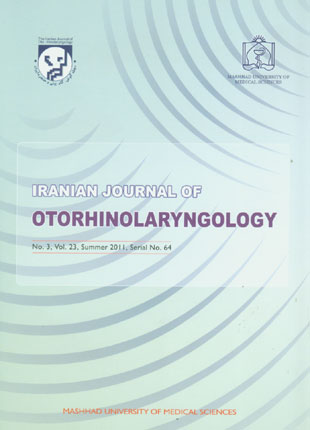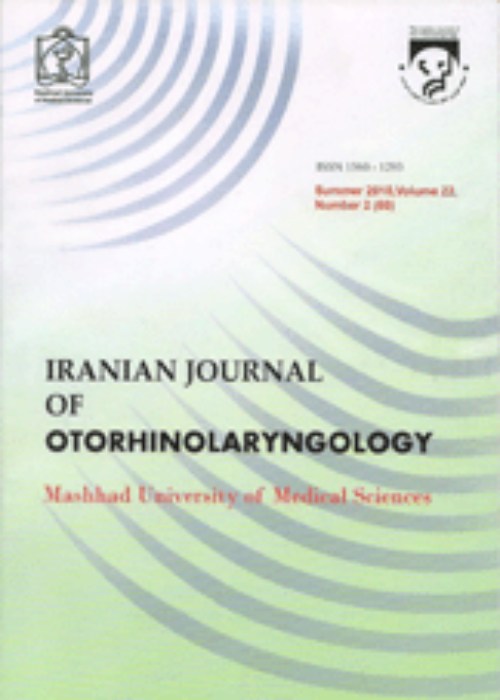فهرست مطالب

Iranian Journal of Otorhinolaryngology
Volume:23 Issue: 3, Summer 2011
- تاریخ انتشار: 1390/03/31
- تعداد عناوین: 8
-
-
Page 61Juvenile nasopharyngeal angiofibroma (JNA) is a rare, benign and locally invasive tumor. Massive bleeding because of vascularity of tumor and postoperative recurrence are potential problems of management. Endonasal approach reduces the rate of postoperative recurrence, intraoperative bleeding, and complications of surgery, time of operation and duration of hospitalization. In this article, we review the indications and contraindications of endoscopic surgery, indications of radiotherapy in treatment of JNA and our policy in postoperative follow-up and management of patients.
-
Pages 69-74IntroductionAdenotonsillectomy is one of the most frequent surgical operations on children, which may result in weight gain in a number ways, for instance, by increasing IGF-1 or decreasing respiratory hyperactivity.Materials And MethodsThis was an intervention study with a control group, conducted on fifty 3-10-year-old children who had undergone adenotonsillectomy and on fifty children as the control group. The intervention and control groups were identical in terms of age and sex. Height, weight, mid-arm muscle circumference, waist circumference, and percent body fat measures were performed on the intervention group before and six months after the surgery. The same measurements were also performed on the control group at zero time and six months later. Ultimately, the results were examined and compared.ResultsThe body mass index (BMI) and percent body fat in the intervention group showed a significant change after six months, with P values of 0.002 and 0.024 respectively. There were no significant correlations for other variables.ConclusionBased on the findings of this study, children who had undergone adenotonsillectomy for various indications showed a gradual postoperative increase in their BMI and percent body fat.
-
Pages 75-78IntroductionManagement of pain in children is often inadequate and numerous clinical practice guidelines and policy statements have been published on the subject of pediatric pain. Tonsillectomy is among the most frequent otorhinolaryngologic surgeries, especially in the pediatric age group and after tonsillectomy the patients usually suffer from mild to severe pain for three postoperative days which may limit activity level and intake, leading to dehydration and a prolonged hospital stay. In this study acetaminophen, acetaminophen codeine and ibuprofen have been compared in a single study.Materials And MethodsA randomized, prospective, double-blind study was conducted at the Tabriz pediatric hospital. Patients were selected randomly from the hospitalized patients undergoing tonsillectomy suffering from recurrent tonsillitis or adenotonsillar hypertrophy and assigned to one of three groups (acetaminophen (ACT)-acetaminophen codeine (ACT/C)-ibuprofen (IBU) according to a predetermined randomization code. All the operations were taken place under same conditions by the same surgeon. Objective pain score used for pain assessment and adverse drug reactions were collected on checklists and analyzed using SPSS software.ResultsChi square test results revealed a significant difference between ACT ACT/C IBU groups. Neither acetaminophen nor Ibuprofen at the doses given was able to provide sufficient analgesia. The rate of bleeding in all groups did not show any significant difference according to Pearson-chi-square test (P=0.22). The incidence of anorexia in ACT, ACT/C and IBU groups was 15.7, 7.8 and 25.8 percent, respectively, which showed a significant difference by chi-square test (P=0.045).ConclusionAccording to our study it can be concluded that acetaminophen codeine posses more analgesic effect than acetaminophen and ibuprofen in post tonsillectomy pain management in pediatric patients.
-
Pages 79-86IntroductionEnvironmental fungi, molds and yeasts, can infest the nasal cavity through inhaled air. There is some evidence that they could be the main cause of Chronic Rhino-Sinusitis (CRS) but little is known about the normal fungal flora in the human nose.The objective of this study was to assess the normal fungal flora of the nasal mucus in adults in Kerman.Materials And MethodsWe conducted a cross sectional study. Nasal swabs were used to sample the nasal cavity of 100 adults, 46 men and 54 women between 17 and 60 years old, currently living in Kerman, Iran.ResultsAmong 100 healthy people, one or more types of fungi were detected in 31 (31%) persons; Candida in 12 persons, Aspergillus in 8 persons, Streptomyces in 8 persons, and Penicillium, Nocardia and Mucor in a few persons. In only 4 persons, more than one type of fungi was detected. There was no significant relation between age, sex, education or smoking with the presence of fungi.
-
Pages 87-92IntroductionThe hepatitis B is a viral infection that causes a big problem globally. About 2 billion people worldwide are infected and there are now about 400 million HBV-DNA carriers around the world. HBV infection is the ninth cause of death worldwide and infects about 350 million new cases each year in the world. HBV-DNA can be spotted in different body secretions and fluids, including serum, saliva, tears, urine, amniotic fluid index, and cerumen isolated.Material and MethodsThis is a case - control study on the population of 140 participants (70 patients with chronic hepatitis B as cases and 70 healthy volunteers community as a controls). The presence of HBV-DNA in their serum and ears cerumen using qualitative PCR and quantitative molecular detection Real-Time PCR (BioRad-CFX system) was determined.ResultsCopy of serum HBV were detected in 98.5 % of case group and 7 % of healthy population (control group). In case group, 61 patients (87.2%) had HBV-DNA in their cerumens and 5control subjects(about 7 %) were positive for HBV-DNA in their cerumens. All patients group and two subject (2.8%)of control group, were positive in HBsAg test.Average HB virus genome load in cerumen and serum of chronic HBV patients (group) were 8.98×106 and 3.60×108 copies per ml of the sample respectively.ConclusionLike other body secretions, Ear cerumen is constantly produced and is subject to a pathogen such as HBV infection. The possiblity of disease transmission seems unlikely through Cerumen, however considering the average copy of HBV genome in the cerumen, no doubt, it can be claimed that there is a potential transmission risk of HBV infection.
-
Pages 93-98IntroductionAlthough the incidence and prevalence of chronic suppurative otitis media (CSOM) has been decreased in recent decades, but it is still a major health problem in both developing and developed countries. CSOM can cause major and life-threatening complications such as hearing loss, meningitis and cerebral abscess. Since hearing loss is the most common complication of CSOM, we aimed to evaluate audiometric profile in patients with CSOM and its relation with intra-operative pathologic findingsMaterials And MethodsBetween 2008-2010, 80 patients with CSOM subjected to tympanomastoidectomy or tympanoplasty entered this study.The detailed patients’ history, physical examination, audiometric evaluations and findings during surgeries were collected. Finally, the associations between data were analyzed.ResultsCSOM had higher prevalence among female (67.5%), but difference was not statically significant. Speech recognition test and air-bone gap were significantly associated with CSOM (P<0.001). While cholesteatoma and granulation significantly associated with air-bone gap (P=0.044) and speech recognition test (P=0.032), respectively, ossicular defects significantly associative with both of them (P=0.001 and P=0.032, respectively). There was not any association between sclerosis and audiometric parameters. Also presence of the cholesteatoma and ossicular defects associated with size of the tympanic perforation (P=0.001).ConclusionThe preoperative and surgical findings can predict the patients’ conductive hearing loss in chronic otitis media, but this relationship is not significant in all variables.
-
Pages 99-102IntroductionAdvanced lip carcinomas can invade adjacent structures. Performing surgery for these cancers will lead to defects in this anatomically and functionally important area and will cause post-op difficulties such as drooling, speech alterations and aesthetic considerations, if not properly managed. Case Report: In this study, we will introduce a radial forearm free flap with palmaris longus tendon to reconstruct a defect of a large lower lip carcinoma. Our patients was a male in the 7th decade of life with an advanced lower lip carcinoma invading the full thickness of the buccal mucosa, left commissure and the left third of the upper lip. Resection was performed with adequate margins; checked by frozen sections and radical modified neck dissection was also performed on the left side. Free radial forearm flap with palmaris longus tendon was harvested and anastomosed in the neck. Four months after surgery commissurroplasty was done and the flap volume reducedConclusionThe radial forearm free flap with palmaris longus tendon provides a good functional lip with a reasonable aesthetics in our patient. The patient was satisfied with the result and there were no functional complaints such as drooling reported by him. We think that this flap could be a flap of choice for reconstruction of the large, full thickness lip defects.
-
Pages 103-107IntroductionMaxillary osteomyelitis is a rare phenomenon. If it occurs, evaluation for underlying disease especially osteopetrosis must be considered. Osteomyelitis occurs as a complication in 10% of the cases of osteopetrosis. Case report: This is a case report of maxillary osteomyelitis presented in a 15-year old boy with osteopetrosis. In this case, the disease represented mainly with facial pain and swelling and also drainage from facial skin fistulas in bilateraral infraorbital area and lower eyelids. Diagnosis was confirmed by clinical and radiological findings. Treatment consisted of surgical debridment and intravenous antibiotic therapy which led to partial response.ConclusionMaxillary osteomyelitis is a rare phenomenon. If it occurs, evaluation for underlying disease especially osteopetrosis must be considered.


